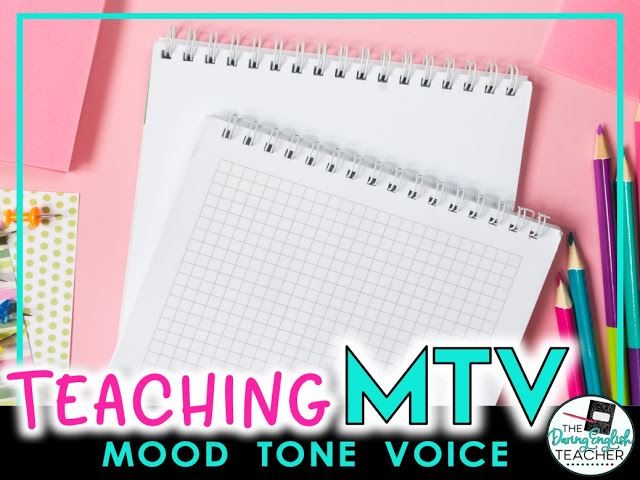Teaching literary analysis in middle school and high school classrooms is much more engaging when you use fun acronyms. When teaching literature in the secondary ELA class, focus on the MTV: mood, tone, voice.
Even for the experienced reader, mood, tone, and voice can sometimes feel impossible to distinguish. So it is natural that students have a tough time understanding mood, tone, and voice.
All three of these elements contribute to the general feel of a story, so what is it that sets them apart? The differences might seem small and seemingly undetectable, but they are very important in helping students understand stories as clearly and accurately as possible.
Since mood, tone, and voice all relate to the feel of a story, it is also through this word feel that we can set them apart. In my sticky note literary analysis teaching unit, I dedicate some organizers to teaching mood and teaching tone in literature.
Have students reflect on the simple questions below to internalize the difference between them.
Mood: How did you, the reader, feel while reading this work?
Mood is a tough thing to quantify. Although authors use plenty of carefully-placed literary devices to evoke a certain mood within a story, the term, in itself, generally refers to more of a feeling. The semantic devices used to create and accentuate this feeling are essential, but they should never be confused with the feeling itself.
With this in mind, ask students, when considering mood, to simply think about how the story made them feel — were they frightened? Nervous? Relaxed? Answering this question honestly, without overthinking, will point students towards the core of what defines mood — that gut feeling we get whenever we encounter something new, that we can’t always put into words (but it is still good to try!)
Tone: How did the author feel while writing this work?
What readers and authors feel are worlds apart. While the author crafts the mood of a story to make readers feel a certain way, the tone is the particular idiosyncrasies authors use to get there.
Imagine: how did they go about writing this work? Quickly and angrily, using curt, unforgiving words? Or did they take their time? Are words more ambiguous, the sentences brooding, and without end? The tone is the author inserting themself between the reader and the speaker; they are that invisible, third-party entity with all the power because they determine both the rules of their world and how they’d like to express this world.
When discussing tone, ask students to consider how the author feels about what’s going on, relative to the story, and how this relates to wider views or messages they are trying to relay. A helpful hint is to look up what was happening socially or politically during the time in which the author wrote the story.
Since tone is something directly controlled and monitored by the author, make sure that students always support their interpretations of a work’s tone by citing the evidence that supports it. For example, make sure students consider how word choice, use of literary and rhetorical devices, sentence structure, pacing, etc. all amount to active choices the author purposefully made to develop and communicate their tone.
Voice: How did the protagonist or speaker of the work feel?
Then there’s the matter of the speaker: this is where voice comes into play. Unlike mood and tone, neither the reader nor the author experience voice.
Rather, voice exists entirely within the realm of the work itself. It does not know who created it, or who is interpreting it, or that its actions and thoughts are open for interpretation. Voice operates solely on behalf of the speaker or narrator of the work — be sure to warn students that this is not always the work’s central character. Perhaps, the character doesn’t even seem to “matter” at all. Yet, of course, the author chose to tell the story from their perspective for a reason. So, what is that reason? It is up to students to find out.
Meanwhile, they must consider how the speaker, as an independent entity, chooses to express themselves. Why do they act, think, and feel as so? Before answering these questions, it is essential that students first identify the story’s point of view.
All in all, students should remember that voice is the unfiltered feeling of a person that doesn’t really exist, but without which the story would not.
When students start to look at the mood, tone, and voice of a story, it will help them develop a better understanding of the text.



